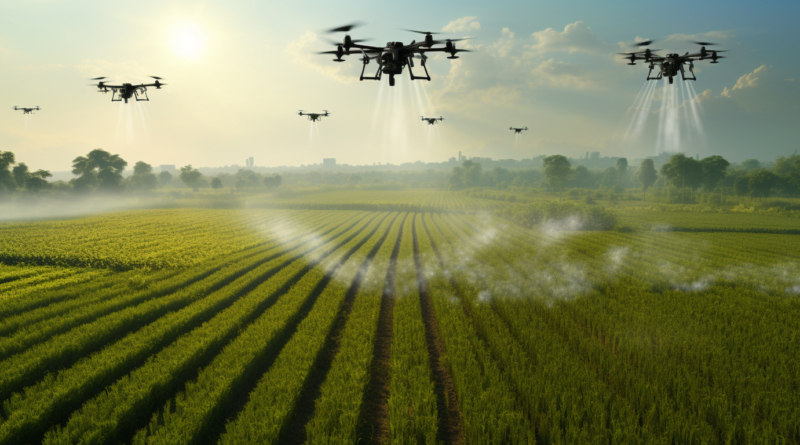
Agricultural Drones Are Low-Hanging CleanTech Fruit For Sustainable Food Production
2 days ago
Derek Markham 9 Comments
Sign up for CleanTechnica's Weekly Substack for Zach and Scott's in-depth analyses and high level summaries, sign up for our daily newsletter, and/or follow us on Google News!
If you’re looking for a clean technology that’s already proven, scalable, and ready to make an impact, look up — literally. Agricultural drones are quietly transforming farming around the world, and they’re doing it in a way that’s fast, efficient, and sustainable. For an industry that’s often slow to change, this is a big deal.
Why Drones? Why Now?
The short version: drones are cheaper, cleaner, and smarter than traditional agricultural methods.
Over 300,000 ag drones are in use globally, according to DJI’s 2023/2024 industry report. They’ve already treated more than 500 million hectares of farmland (PDF). That’s not hype, it’s actual impact. These drones have helped save over 210 million metric tons of water and 47,000 metric tons of pesticides. They’ve also helped cut carbon emissions by over 25 million metric tons. That’s the same as planting 1.2 billion trees.
So why isn’t every farmer already using them?
The Old Way Is Broken
Traditional farming tools — big tractors, crop dusters, and lots of human labor — are expensive, inefficient, and hard on the planet. Tractors compact soil, reducing yields over time. Planes overspray, wasting chemicals and polluting nearby waterways. Manual labor is costly and increasingly hard to find.
Drones avoid all of that. They don’t crush soil. They don’t waste spray. And they don’t burn diesel. They’re lightweight, electric, and precise. It’s clean technology in a sector that badly needs it.
Precision Matters
When it comes to food production, precision is everything. A small improvement in pesticide application or water usage can lead to big gains in yield, and big savings.
Take a potato farmer in Washington State. Instead of spraying his whole 60-hectare field, he used drones to spot-spray only the affected areas. The result? An 80% drop in insect damage. Less pesticide, fewer pests, better crops.
In South Africa, sugarcane farmers using drones increased their sugar yield by up to 1.78 tons per hectare, just by applying treatments more accurately. And in Mexico, agave farmers cut their water use by 88% with drone spraying. It saved them over $60 per hectare. That’s real money.
Cleaner Tech, Lower Emissions
Here’s where the cleantech story gets even stronger: most ag drones run on electricity. That means fewer emissions compared to diesel-powered tractors or crop dusters, and this shift to electric aerial spraying is already making a measurable dent in agriculture’s carbon footprint.
And there’s more. Because drones are so precise, they use fewer chemicals. That reduces runoff into rivers and lakes, helping to prevent algal blooms and water contamination. It also means fewer chemicals in the soil, which is good news for long-term fertility.
Smarter Farming With AI & Data
Modern ag drones do more than just spray. They gather data, use AI to analyze it, and give farmers insights they didn’t have before. Want to know which part of your field needs more nitrogen? The drone can tell you. Want to catch a pest outbreak before it spreads? The drone sees it coming.
That kind of real-time, high-resolution feedback is changing how farmers make decisions. It means fewer blanket treatments and more targeted action — healthier crops, lower costs, and less environmental damage.
Economic Wins, Not Just Environmental Ones
Let’s talk money.
Using drones instead of traditional methods saves farmers on fuel, labor, and chemicals. But it’s not just about cost-cutting. It’s about opening new opportunities. The drone industry itself is expected to create over 100,000 new U.S. jobs by 2025, according to the Association for Unmanned Vehicle Systems International (AUVSI). Many of those roles will be in agriculture — drone pilots, data analysts, and maintenance technicians.
And here’s a bonus: drones are making agriculture more appealing to younger people. In many regions, farming has an aging workforce problem. But with drones and smart tech entering the picture, younger generations are taking a second look at ag careers.
Real-World Results, Real Fast
Still think this is niche tech? Think again.
In Thailand, durian farmers using drones reduced pesticide use by 20–30% without sacrificing yields. In Indonesia, rice farmers found that drone spraying cut herbicide use nearly in half, while improving crop quality. And in Brazil, drone use in soy and corn fields has exploded — more than 110,000 registered flights, treating over 1.5 million hectares.
The technology isn’t just available. It’s working, at scale, right now.
300,000 Agriculture Drones Worldwide

DJI Agriculture
23.6K subscribers
DJI Agriculture drones are transforming farming practices on a global scale. With their innovative technology, these drones are ushering in a new era of agricultural efficiency and sustainability.
youtube.com
What’s Next?
The trajectory is clear: agricultural drones are moving from early adoption to mainstream use. As the hardware gets cheaper, the software gets smarter, and regulations catch up, expect even faster growth.
And for the cleantech community, this is an obvious win. Here’s a technology that lowers emissions, reduces waste, protects soil and water, and boosts food security — all without waiting on some hypothetical breakthrough.
Final Thoughts
Agriculture is one of the biggest sources of carbon emissions, and one of the hardest to decarbonize. But with drones, we’ve found a clean tech solution that’s ready to scale today. It’s already cutting emissions, reducing chemical use, and helping farmers do more with less.
No silver bullet exists for climate change or food security. But agricultural drones come pretty close to being a low-hanging fruit — ripe, reachable, and worth picking now.
cleantechnica.com |





